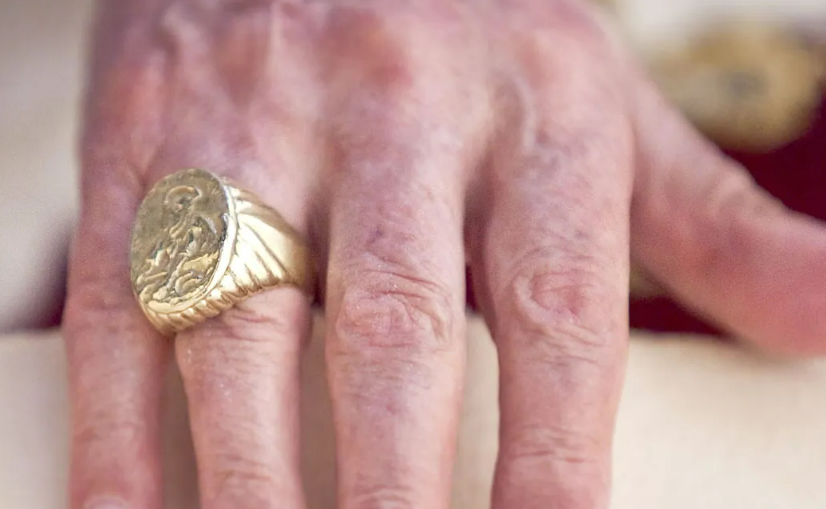Why Papal Signet Rings Are Destroyed: The Case Of Pope Francis

Table of Contents
The Historical Significance of the Fisherman's Ring
The Papal Signet Ring, also known as the Fisherman's Ring, is far more than an ornate accessory. Its significance stems from centuries of tradition and its deep connection to the very foundations of the Catholic Church.
Symbolism and Authority
The ring's design typically features St. Peter, the first Pope, engaged in fishing. This imagery symbolizes St. Peter's role as a "fisher of men" and represents the ongoing spiritual authority bestowed upon his successors. The ring serves as a tangible link to this historical lineage, a visible emblem of the Apostolic See's unbroken chain of leadership.
Use in Papal Documents
Historically, the Fisherman's Ring was crucial for authenticating official Papal documents. Its use ensured the legitimacy of papal decrees, bulls, and other pronouncements. The ring's unique design and the Pope's personal possession made forgery virtually impossible, safeguarding against fraudulent pronouncements and maintaining the integrity of the Church's pronouncements.
- Design Elements: The ring typically features an image of St. Peter fishing, often with a key or other symbolic elements. Variations exist across different papacies.
- Historical Use: Throughout history, the ring’s impression was affixed to papal documents, lending them undeniable authenticity. Examples abound in papal archives.
- Forgery Prevention: The unique design and personal nature of the ring served as an essential security measure against fraudulent documents.
Reasons for the Destruction of Papal Signet Rings
The destruction of the Papal Signet Ring upon a Pope's death or resignation is not a capricious act; it's a deliberate ritual with profound symbolic and practical significance.
Preventing Forgery and Misuse
The primary reason for destroying the ring is to prevent its misuse. After the Pope's death or resignation, the ring’s destruction immediately invalidates any document sealed with it, preventing potential forgeries and the abuse of papal authority. This safeguard protects the Church's integrity and prevents any unauthorized actions from being presented as legitimate papal pronouncements.
Symbolic Ending of a Pontificate
The destruction of the ring acts as a powerful symbolic closure to a papacy. It marks the definitive end of that particular pontificate, signifying the transition of power to the new Pope and preventing any confusion or claims of continued authority by the previous pontiff. It’s a visual representation of the conclusion of an era in the Church's history.
- Destruction Ceremony: The ceremony surrounding the ring's destruction varies, but often involves crushing or melting the ring.
- Historical Accounts: Accounts from throughout history detail the meticulous process of destroying the ring, emphasizing the solemnity of the occasion.
- Previous Popes: The destruction of the ring has been a consistent practice for centuries, across numerous papacies.
Pope Francis and the Papal Signet Ring
Pope Francis's approach to the Fisherman's Ring aligns with this long-standing tradition. While details of his specific actions remain private, the inherent symbolism and the prevention of future misuse remain central.
Francis's Approach
While specific details about the destruction of Pope Francis's ring may not be publicly available for privacy reasons, it's safe to assume that it followed the established tradition of ensuring the ring's destruction to prevent forgery or misuse.
Modern Implications
In our modern digital age, the need for a physical signet ring to authenticate documents might seem archaic. However, the symbolic power of the ring's destruction remains crucial. It represents a clean break, a decisive end to a pontificate, and a clear transition of spiritual authority. The enduring importance of this ritual highlights the continued relevance of traditional practices within the Catholic Church.
- Francis's Use: Pope Francis, like his predecessors, has undoubtedly utilized the ring for official purposes during his papacy.
- Deviations from Tradition: It's unlikely Pope Francis deviated significantly from the established tradition concerning the ring's eventual destruction.
- Impact of Technology: While digital signatures and authentication methods are now prevalent, the ritual destruction of the Fisherman's Ring preserves a potent symbolic tradition.
Conclusion
The destruction of Papal Signet Rings, including that of Pope Francis, is a long-standing tradition rooted in preventing forgery, symbolically ending a pontificate, and upholding the integrity of the Papacy. This ritual, though seemingly simple, holds profound historical and symbolic weight. The continuation of this practice under Pope Francis underscores its enduring significance within the Catholic Church. To learn more about this fascinating aspect of papal history and the significance of the Fisherman's Ring, explore resources on the history of the papacy and the symbolism within the Catholic Church. Further research into the destruction of papal rings and the significance of the Fisherman's Ring will reveal further intriguing details about this age-old tradition.

Featured Posts
-
 Anchor Brewing Companys Closure 127 Years Of Brewing History Concludes
Apr 23, 2025
Anchor Brewing Companys Closure 127 Years Of Brewing History Concludes
Apr 23, 2025 -
 Deretan Program Tv Spesial Ramadan 2025 Panduan Lengkap Acara Jelang Buka Dan Sahur
Apr 23, 2025
Deretan Program Tv Spesial Ramadan 2025 Panduan Lengkap Acara Jelang Buka Dan Sahur
Apr 23, 2025 -
 Brewers Historic Rout Of Athletics A Record Breaking Performance
Apr 23, 2025
Brewers Historic Rout Of Athletics A Record Breaking Performance
Apr 23, 2025 -
 Ai And Wildlife Conservation Progress And Perils
Apr 23, 2025
Ai And Wildlife Conservation Progress And Perils
Apr 23, 2025 -
 Netflix Weathering The Tech Storm Attracting Investors Amidst Tariff Concerns
Apr 23, 2025
Netflix Weathering The Tech Storm Attracting Investors Amidst Tariff Concerns
Apr 23, 2025
Latest Posts
-
 Troubled Nhs Trust Leaders Commitment To Nottingham Attack Inquiry
May 10, 2025
Troubled Nhs Trust Leaders Commitment To Nottingham Attack Inquiry
May 10, 2025 -
 Nottingham Attack Inquiry Nhs Trust Chief Pledges Cooperation
May 10, 2025
Nottingham Attack Inquiry Nhs Trust Chief Pledges Cooperation
May 10, 2025 -
 Amy Walsh Defends Wynne Evans Following Strictly Comment
May 10, 2025
Amy Walsh Defends Wynne Evans Following Strictly Comment
May 10, 2025 -
 Go Compare Ad Campaign Controversy Wynne Evans Removal Following Sexism Claims
May 10, 2025
Go Compare Ad Campaign Controversy Wynne Evans Removal Following Sexism Claims
May 10, 2025 -
 Wynne And Joanna All At Sea Where To Find The Book
May 10, 2025
Wynne And Joanna All At Sea Where To Find The Book
May 10, 2025
